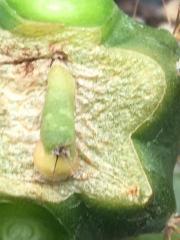-
Posts
60 -
Joined
-
Last visited
-
Days Won
3
Elrik's Achievements
Newbie (1/14)
-
-
When Lophs set seed without input from an outside pollen source is it actually using its own pollen and producing a recombination of its own genetics or are the female cells being induced into apomixes to produce clones in the form of seed? [This phenomena is common in cacti] I've always heard it referred to as selfing but I cant find any evidence to back that up in genus Lophophora. On the other hand I received a single fruit and got two plants from it, if I cross them I still only get 1-3 seeds per fruit and one of their offspring is now adult and backcrossing it to either parent only produces 1-3 seeds per fruit as if it were simply setting seed without pollen input. Are all my specimens from that bloodline apomictic clones?
-
A month later, one has put up a shoot The current round of clones is being made with 3 times the length of stem and planted vertically. They'll probably grow 3 times as fast. I just got a Pereskiopsis aquosa clone, though, and I may try the single node cloning again with it so it can catch up to my P. spathulata numbers.
-
-
Fertilized my Lophs. To keep them from being buried in mud when it rains I plant them on level, or even slightly elevated ground. That way I can just rinse off the mud spatters with a spray bottle. This, however, makes deep watering tricky. I took milk jugs, cut a hole in the top, and drilled a 1.5 mm hole on one of the sides nearly on the bottom. Rocks or disks of tree branch keep the jugs from touching the buttons. And the small size of the drain hole lets the fertilizer water actually soak in before getting too far from the jug. I also spotted a long hair tuft growing on a button from a genetic group thats never flowered for me. First flower may be on the way
-
That one is growing quite well this year, its been one month since transplant and its already visibly larger. It just reached 40 mm in diameter, I like hidden baby trich stock. I noticed a few more pups forming at its base. I've never seen it said in words but I've assumed from many pictures that the fastest way to get caespitosa to flower is to keep cutting off the pups until they put out several flowers. Has that been anyones direct experience? From what I remember of cactus porn the primary head gives its first flowers around, what, 5 cm?
-
For the record, it was the urea. Gypsum is used as a stabilizer to slow the degradation of urea so some companies make mixed gypsum/urea pellets. What I've been collecting is low density gypsum pellets left after the urea dissolved out. I suppose I'll find a cactus mix to use it in. Or I perhaps my tomato bed would like it. So, urea based fertilizer that doesnt fully dissolve: suspect gypsum.
-
Well my jusbertii fruits aborted. One got its pollen from Echinopsis subdenudata and the other from Gymnocalycium baldianium. I had high hopes for the Echinopsis. Next comes Setiechinopsis, which itself has a longer flower tube so the pollen can grow as long as a jusbertii flower. Beyond that this year I'll only have Mammillaria, Lophophora, and a variety of old stored Opuntia pollens. Is there any species particularly good at acting as mentor pollen to induce selfing or apomixes broadly across many genera so we can get fruit? One guy on a russian cactus forum suggested Hamatocactus setispinus as being effective with Astrophytum spp. as a second best. I at lest have some Astrophytum seed
-
Thats cute I sure am glad they can be done this way, due to neglect I came embarrassingly close to loosing all my pereskiopsis and now I'm repopulating from extremely weak stock. In six months I'll be sleeping in a forest of them, though.
-
Yeah, I anticipated the extremely skinny growth that is likely to occur. I'm actually doing a parallel experiment to see if I can compensate for that. Cacti tend to fatten up in strong light so I took a very skinny [like 3 mm] very small rooted peres cutting and planted it in a 6 cm wide 9 cm tall square pot 1/3 filled with soil. The plant just comes up to the rim of the pot. I'm now hardening it off to full sunlight. Once it grows well above the rim of the pot I'll snip off the lower leaves and fill the pot with soil and watch to see how well it fattens up. I should have those results in before these baby clones are ready for that treatment.
















